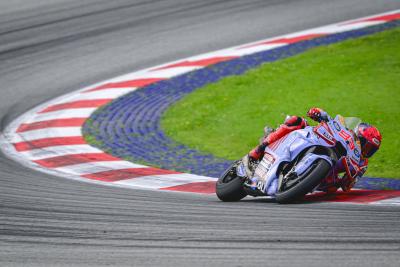Marc Marquez looking to confirm Austrian MotoGP speed at Aragon GP
A special rear tyre construction blurred the picture for Marc Marquez at the Austrian MotoGP, where he showed competitive speed.
Marc Marquez hasn’t been on the podium since MotoGP returned from its summer break, although in Austria that wasn’t for a lack of speed.
A poor start, caused by a failure in engaging his front start device as he rolled up to his third-place grid position, dropped him to 14th at the first turn. Recovering to fourth, once Marquez got clear air he was able to show better pace than third-place finisher Enea Bastianini, and similar to that of the leading pair: Jorge Martin and the eventually victorious Francesco Bagnaia.
However, Marquez’ improvement in performance over the preceding British Grand Prix, for example (where Marquez also finished fourth), came on a slightly odd weekend in MotoGP regarding the tyres brought to the race by Michelin.
The repetitive hard accelerations at the Red Bull Ring mean the circuit is especially stressful for the rear tyre, which experiences extreme loads and therefore heats more significantly than in other circuits. To deal with this, Michelin uses rear tyres with a harder construction, compared to the standard rear tyre, at the Austrian Grand Prix, effectively changing the technical package for all motorcycles for this race (as well as the Thai and Indonesian Grands Prix where the same construction is used).
The change in tyre construction means that Marquez is cautious about being able to carry his performance from Austria forwards into the coming races.
“The [tyre] casing changes again to Aragon to a standard one,” Marquez told TNT Sports after the Austrian race. “We will see if I feel really good on the bike for that special casing for Austria, or [also] with the [standard 2024] casing — we will understand [in Aragon].”
This weekend, MotoGP heads to Aragon for the first time since 2022. The Aragon Grand Prix skipped 2023 as the MotorLand circuit underwent a resurfacing project, which means the circuit should provide more grip this year than in the recent editions of the race.
This creates another standout race from a tyre perspective, as Michelin takes compounds towards the harder end of its spectrum. More importantly, though, it will also take three rear compounds, rather than the usual two, not only for the new surface but additionally for the time of year, as the earlier date for race this year means that track temperatures are likely to be higher than those seen in the past.
“Controlling wear and heat will be the two main challenges of the weekend,” said Piero Taramasso, Michelin Motorsport Two-Wheel Manager. “Given the expected conditions, we have chosen fairly hard rubber compounds from our new ranges, as track temperatures here could reach 50C.
“Two years ago the race took place on 18 September, with slightly less complex weather, and also on a track whose surface we knew very well.
“Given the new asphalt, the configuration of the circuit and the significant constraints that this track exerts, both for the front and rear tyres, we are now starting from scratch with new rubber.”
MotorLand was always one of the most difficult circuits on the calendar for managing the rear tyre. Its number of long-radius corners means that conserving edge grip is challenging, not unlike Silverstone, for example, where Marquez struggled earlier this month.
The anti-clockwise Aragon, though, has always been one of Marquez’ best tracks, winning there in 2013, 2014, 2017, 2018, and 2019 in the premier class.
His two most recent visits, though, were less successful, beaten in a late-race duel by Francesco Bagnaia in 2021, and crashing out on the opening lap in 2022.
“It’s true that, as I said in Sachsenring and as I said in Austin, Aragon is a circuit that I like,” Marquez said. “Doing a perfect weekend, then maybe we will have some chance to fight with the top guys. But we know that they are super-fast, and even with perfect conditions and a perfect performance it will be difficult to fight with them.”


![Johann Zarco, LCR, Honda RC213V, 2024 San Marino MotoGP, Misano, action [Gold & Goose]](https://cdn.crash.net/styles/thumbnail/s3/2024-09/GnG_1166323_HiRes.jpg?itok=vpgrU7Q4)

![Jack Miller, KTM Factory Racing, KTM RC16, San Marino MotoGP, Misano, action [Gold & Goose]](https://cdn.crash.net/styles/thumbnail/s3/2024-09/GnG_1167624_HiRes.jpg?itok=iz7mA4EQ)


![Fabio Quartararo, Monster Energy Yamaha Racing, Yamaha M1, 2024 MotoGP, Misano Test, action [Gold & Goose]](https://cdn.crash.net/styles/thumbnail/s3/2024-09/GnG_1168928_HiRes.jpg?itok=fcYSole_)
![Toprak Razgatlioglu, ROKiT BMW Motorrad, BMW M 1000 RR, Magny-Cours, WorldSBK [Gold & Goose]](https://cdn.crash.net/styles/thumbnail/s3/2024-09/GnG_1165133_HiRes.jpg?itok=GD5SVNVG)

